Vätternrundan – more than just a bike ride around a lake
At moomoo, in addition to our day job of making cycling apparel, we also find time for cycling, or rather, this is part of our job description (regrettably, outside of working hours). Today, instead of focusing on cycling apparel as usual, we will write about the three of us cycling around the sixth largest lake in Europe, which is in Sweden. Hopefully, a few cycling enthusiasts will learn from this article about a new, exciting goal to pursue. In fact, not so long ago, most of us had never even heard of Vätternrundan, a 300-kilometre-long recreational bicycle ride.
Lake Vättern, Sweden. A blue line indicates our route, ridden clockwise.
As for Allan Oras, founder of moomoo, his entire life has been all about cycling, but the same cannot be said either about me, Martti Sala, or Timo Saabas, head designer at moomoo. Both of us caught the cycling bug in connection with our current profession and that’s how it should be. During the season, we gather feedback about our cycling apparel from professional athletes, the so-called brand ambassadors, as well as amateur cyclists, but when it comes to first-hand (and sometimes time-critical) analysis of new or modified models – it is entirely up to us.
What’s more, testing and training can be quite entertaining, but it is bigger goals that give purpose. After the first long cycling tours in spring, Martti started to look for such a goal. Vätternrundan as a potential option was under consideration as early as that, but we were also well aware of the fact that registration for the event had probably closed. However, we were lucky to learn that we were allowed to sign up even in late February. This was not an opportunity to miss out on and that’s how we spent the next four months preparing for the ride – indeed, no joint training session went by without the subject of Vätternrundan coming up.
Our group was joined by one more member, Priit Salumäe, marketing director at Hawaii Express. We organised the logistics of the entire trip with a large group of Estonian journalists who were also going to cycle around Lake Vättern as a part of the En Svensk Klassiker, or Swedish Classic Circuit series. The Swedish Classic Circuit series of sporting events includes Vasaloppet (90 km of cross-country skiing), Vätternrundan (300 km of cycling), Vansbrosimningen (3 km of swimming) and Lidingöloppet (30 km of cross-country running).
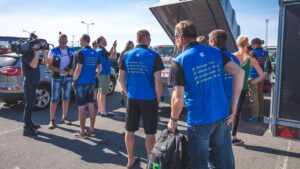
Journalists and other participants in the Swedish Classic Circuit series cycling race, Tallinn.
On the ship, a briefing was held for all of those travelling together, during which Priit shared his previous experiences of participating in the ride and Allan encouraged the first-timers. Inspired by our enthusiasm and passion, a sizable portion of the journalists’ group considered joining us during the ride. There was pre-ride excitement in the air radiating from some members of the company. I must admit that even for me, as more than a bit of a worrier, the entire pre-start period was stress-free. In part, it was due to the fact that at this point I simply wasn’t anxious about the sheer distance ahead of us, not yet, but for the most part my peace of mind was instilled by the fact that I was going to set out with Allan and Priit, the most experienced and knowledgeable among cyclists. Who else could I rely on, if not them?
Our planned riding speed was 30 km/h, quite tempting for more than a few journalists. The ride was supposed to show whether we are able to keep up this average speed with breaks included or only when moving. According to a simple calculation, at this speed, the ride should take around ten hours to complete. Martti was not sure whether Priit and Allan would be able to hold themselves back at such a low riding speed.
Although Vätternrundan is a recreational, not a competitive event, every participant is welcome to set individual goals for the ride. 23,000 riders will be released at intervals within 36 hours: a group of 60 starts every two minutes.
The indicated starting time for the four of us (Allan, Priit, Martti and Timo) was at 5.36 a.m., that is, two minutes after the journalists. Assuming that we would soon catch up to them, this presented a perfect opportunity for the previously mentioned journalists to join our group. An overview of the journalists’ highlights, including a three-part video recap on Vätternrundan, is available on the website of the Reporter programme on channel Kanal 2. https://reporter.postimees.ee/search?query=svensk
Our team spirit was further strengthened by uniforms designed by Timo especially for the event. The goal was to be easily recognisable to each other as well as to others when riding in a larger group, and, obviously, to achieve all that with a moomoo-ish twist. I give you my word that among groups sporting calm, conservative, characteristically Nordic colour schemes, there was no chance of losing sight of each other. Everyone can decide for themselves, judging by the photos, to what extent we managed to achieve our other goals.
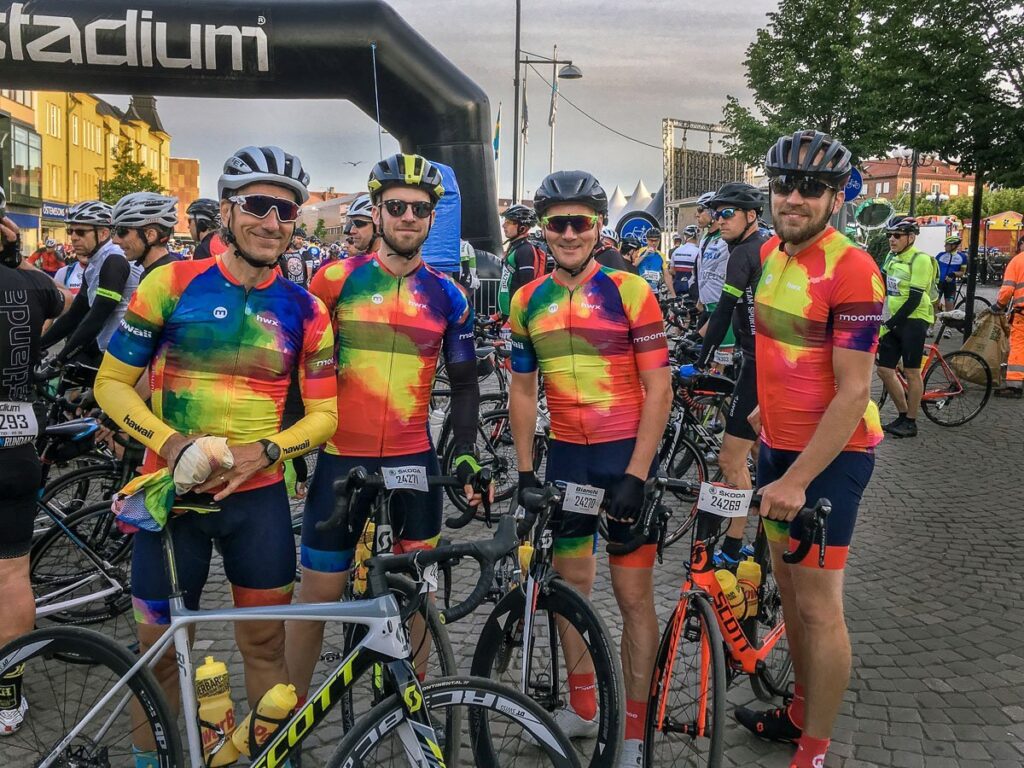
Right before the start. During the ride we tested various paddings, silicones, calf lengths and seamless technologies. From left: Priit, Timo, Allan and Martti.
We had to get up three hours before the official starting time because we were staying in the town of Motala, which is some 100 km from the starting point. All pre-start preparations went smoothly and, taking into account the goal we had set for ourselves, we were really lucky with our starting group as well. For the first few kilometres, each group was secured by a motorcycle, but after it left, leading riders promptly increased the speed up to 33-35 km/h. In just a few minutes, we overtook the Estonians who had started two minutes earlier, while we caught up to the whole starting group of journalists somewhere around the 20th kilometre of the ride. At this point, our bunch was joined by Raivo Rimm and Rasmus Kagge. Some twenty minutes later we, in turn, were overtaken by another faster-moving group. Both bunches joined to form one larger group moving ahead in a double paceline at a speed of almost 40 km/h. Unlike bicycle rides in Estonia, groups at Vätternrundan, as a rule, ride in two lines side by side.
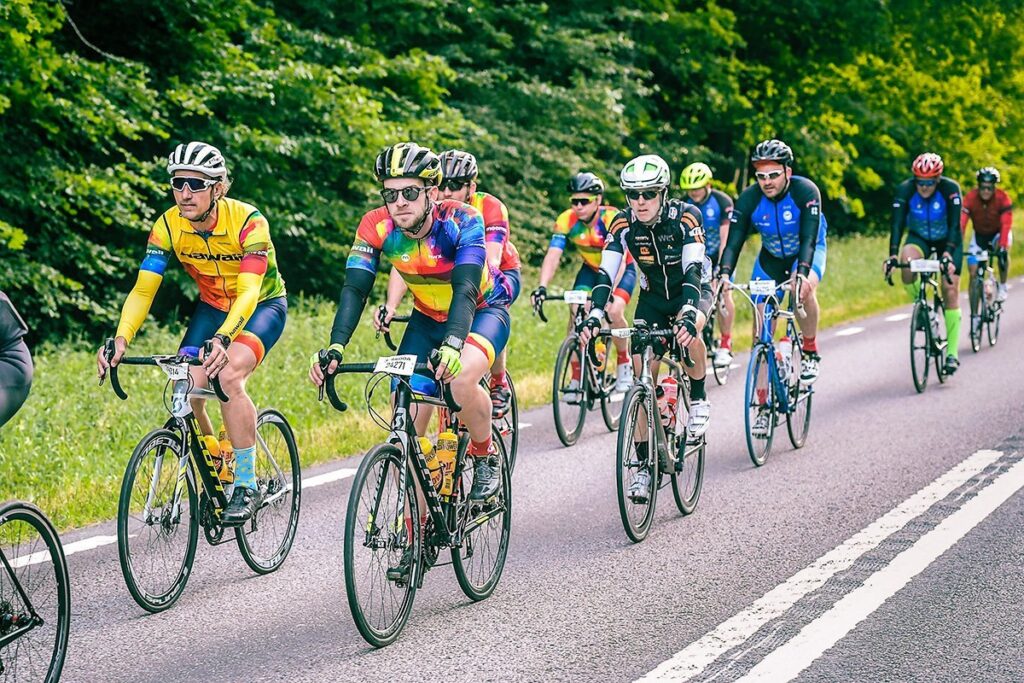
The entire ride takes place in normal traffic conditions. Riding in a double paceline makes it possible to safely take up just one lane. Priit and Timo at the front, journalists Rasmus Kagge and Raivo Rimm at the back (in blue), still with our group.
There were nine service and food stations along the 300-kilometre-long distance, some of which were a few hundred metres from the official route. To get to such a service area, you had to park your bicycle and continue on foot. When riding against the clock, such an arrangement translates into a considerable loss of time.
We had been riding with our not-so-small group for some 80 km and decided to make our first stop to stock up in the city of Jönköping, at which point we would have covered 104 km of the entire route. By now, the journalists who had previously joined us had, one by one, surrendered to our tempo. However, this doesn’t mean that we were riding at some otherworldly speed as there were lots of Estonians and other faster riders ahead of us.
In Jönköping we took a brief toilet break, refilled our drinking bottles and moved on. Although the break didn’t take us longer than a few minutes, we were quite alone when back on track: ahead, there was nobody in sight, and it wasn’t an option for us to wait for a slower group to catch up. Psychologically, this was one of the most challenging moments because while up to now we had done better than expected, the road ahead appeared grim.
It seemed that the first 100 km had had no adverse effect on us; plus the short break had been really refreshing. So it seemed only logical for our group of four to start moving, taking turns to be in the lead (we couldn’t be sure that our efforts would bear any fruit). Over the next few dozens of kilometres our average speed dropped considerably due to this section being one of the hilliest of the entire route.
It was really enjoyable for the entire ride to see that larger groups, almost exclusively, took the climbs casually. In addition to this being a very reasonable course of action, taking into account the route’s length and how the riders are feeling, it turned out to be quite useful for us in chasing larger groups. As a result, we were able to catch up to a larger group after 30 kilometres of hard work and from there onwards, it was much easier to continue. As for the route now, the slopes were becoming gentler and our average speed increased once more.
We agreed to make the next stop at a service station in the town of Hjo, at which point we would have covered 171 km of the route. As previously, the group moved on and it was only us who slowed down. Priit had taken such good care of our food provisions that all we had to do was refill our drinking bottles and answer to the call of nature. True, we had agreed that we would eat a traditional Swedish raisin bun at least once during the ride.
Martti and Timo waited for Allan and Priit who, with their half-filled bottles, went on a hunt for the buns. We had not done thorough homework on the service stations; we knew that lasagne was served at one station, but at which one exactly, we had no idea. Needless to say, this turned out to be the station at Hjo, which meant that there were huge queues. Thus Allan and Priit returned empty-handed, not only without buns, but also without drinking supplies. So, all we had to show for this stop was empty bladders and seven minutes lost.
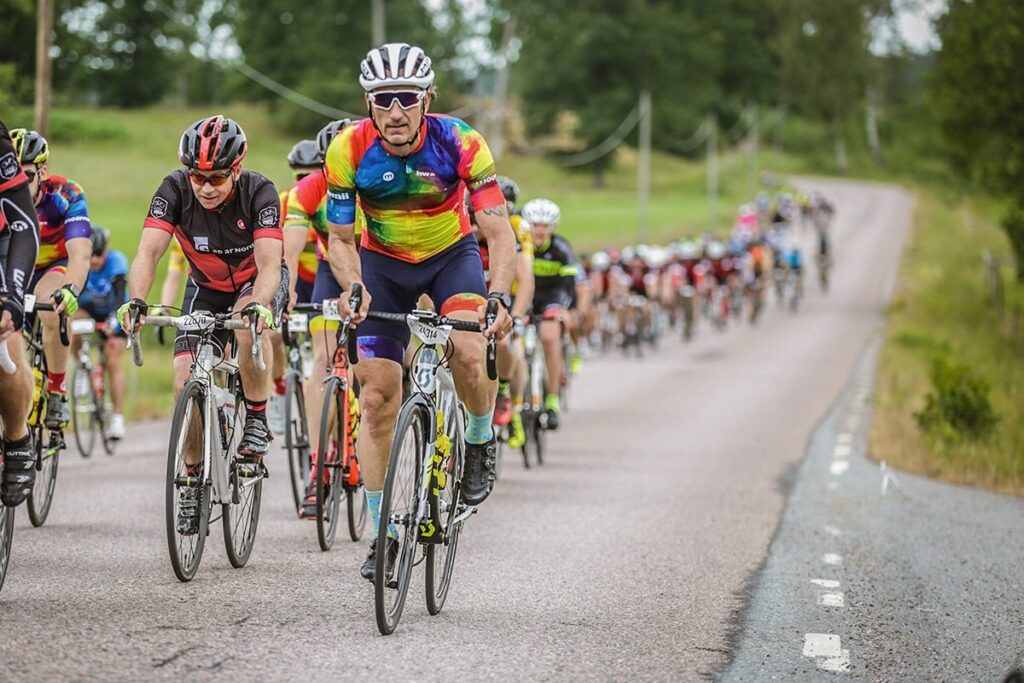
Groups may turn out to be quite large; it is no exception to see groups consisting of some hundred cyclists Priit climbing a slope.
Now we faced the same scenario as after our very first stop: we were back on track and there were no groups to be seen. But now we were starting to feel a little tired and we were slightly alarmed by our half-empty bottles. Mentally, that was the second difficult moment we had to overcome that day. The prospect of the four of us building up speed once again and taking turns to be in the lead wasn’t a very appealing one, mainly because there was no way to know whether quickly putting our remaining strength into use would bring any results, that is, whether we would be able to catch up to a larger group, or we would simply race and make an effort in vain.
After a few kilometres of casual cruising and persuading each other we finally decided to take our chances, so that on gentle terrain the speedometer consistently displayed readings of 40 km/h or even more. After a dozen kilometres we were joined by two younger locals. They were probably hoping for a “free ride”, but before long they were working equally as hard.
Over a section of 30 kilometres our average speed fluctuated between 37-39 km/h, but luckily it wasn’t for nothing. Our efforts did pay off: by now, we had covered 210 kilometres and managed to catch up to larger group. However, this delivered a devastating blow to our already meagre drinking supplies.
We passed the service station in Boviken (225 km) without breaking away from the group or stopping, which doesn’t mean we didn’t consider it. Some 15 kilometres later, we had run out of drinks and there was not a drop left in our bottles. It was at this point we made a decision, which in hindsight seems to be an insane one, namely to attempt to cover the rest of the distance without any stops. Still, we set a condition that if any of us “hit a wall,” we would all take it easy and recover in one of the last two service stations. Three of us were riding with one large (0.7 l) and one small (0.55 l) bottle, which means that with one incomplete re-fill we had consumed less than two litres of liquid in six and a half hours. Needless to say, this quantity simply isn’t enough. Except for the early morning hours, the weather was warm and we were riding in short uniforms.
Just to let you know, we managed to cross the finish line without any additional breaks because our group was moving at a reasonable pace and the rest of the distance was not too serious an ordeal. And yet, 25 km before the end, Priit decided that he would like to finish separately from the large group and made a few quick moves on a climb, hoping to leave our group of some hundred riders behind. He was wrong. As a result of his tactics, we ended up racing the last 25 km of the ride. While all the other racing episodes during the ride had a clear goal and were thus justified from my point of view, I failed to grasp the aim of the last one.
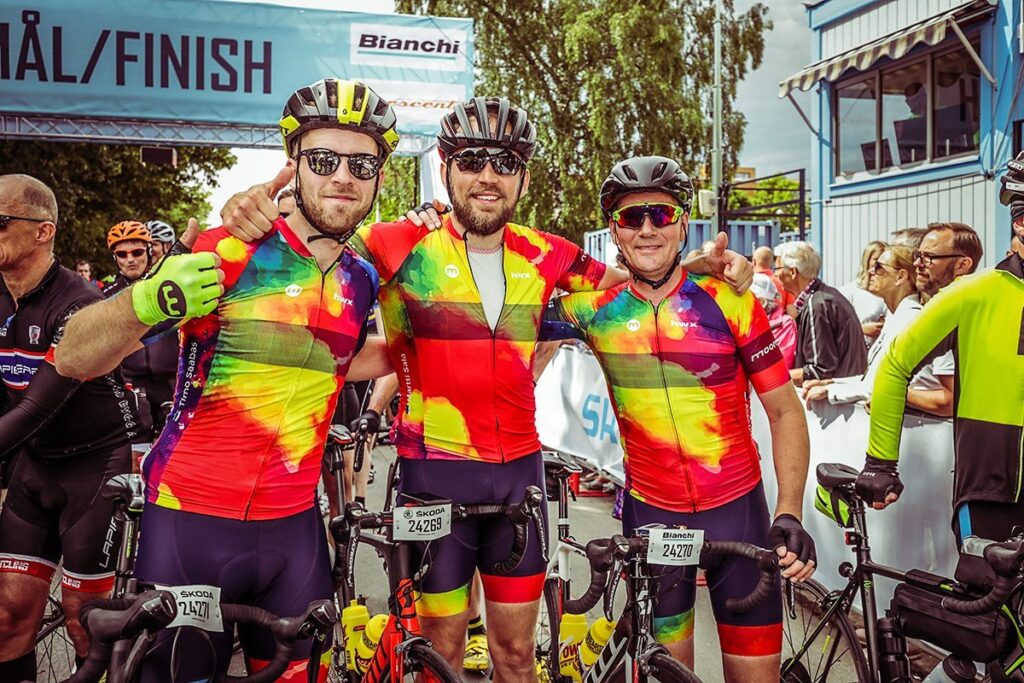
Timo, Martti and Allan right before receiving their medals. Priit did finish, too. Take my word for it.
We had to cover the last two hundred metres before the finish line on foot because participants had simply jammed up the home straight. Including the walk, we had stopped only for 11 minutes in total, and ridden for 8 hours and 23 minutes at an average speed of 35.4 km/h. So, what actually held us back from taking an earlier break to refill our bottles or simply riding at a more leisurely pace?
It had been always clear that merely completing the Vätternrundan ride was not a challenge for any of us, especially not for Priit or Allan. We knew beforehand that this would be a race against the clock and the speedometer. Although we had set clear initial goals, actual goals took shape in the course of the ride. To us, this was not just another bicycle ride around a lake, but a competition, a race together with all of its grand and not so grand moments: during the route we sped up, made stops, lagged behind, ate and failed as well as made smart use of strategy and teamwork.
After finishing, emotions ran high, so high that we were unable to comprise the entirety of our experience. It was only in the next few days that we started to make sense of it all, analysing in detail what we had actually gone through.
Would we do it again? Yes, it is definitely worth it for its own sake, but first and foremost for the joy of riding and the company! So, Vätternrundan comes highly recommended!
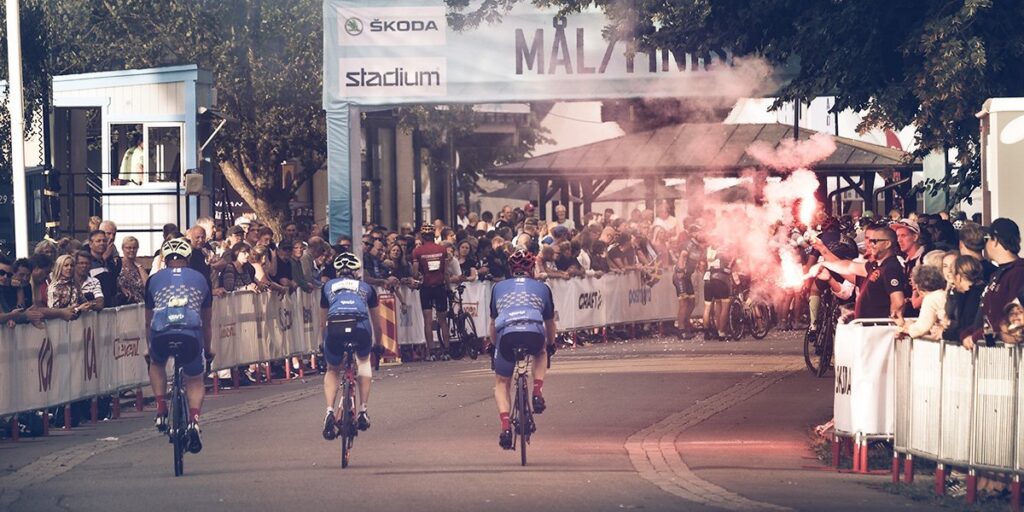
Who knows, maybe you will receive a welcome as fiery as ours at Vätternrundan’s finish line!
Written by Martti Sala
Photos from: Sportfotograf and Martti Sala